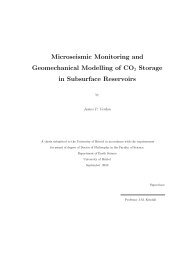MSAT - University of Bristol
MSAT - University of Bristol
MSAT - University of Bristol
You also want an ePaper? Increase the reach of your titles
YUMPU automatically turns print PDFs into web optimized ePapers that Google loves.
ing and modelling the seismic consequences <strong>of</strong> anisotropy.<br />
Since studies <strong>of</strong> seismic anisotropy rarely end with its measurement, modelling<br />
tools are needed to provide explanations for its physical origin and to yield<br />
useful geological or geophysical information. Seismic anisotropy reflects an underling<br />
anisotropy in the elastic properties <strong>of</strong> the material through which the<br />
waves propagate. More than two elastic constants (e.g. the bulk and shear<br />
moduli) are needed to describe the relationship between stress and elastic<br />
strain. Indeed, in the most general case 21 distinct elastic moduli are needed<br />
to link the six components <strong>of</strong> the general stress tensor to the six components<br />
<strong>of</strong> the strain tensor or to calculate the velocities <strong>of</strong> seismic waves propagating<br />
through an anisotropic body. This makes s<strong>of</strong>tware designed to handle<br />
anisotropic elasticity more complex than codes limited to the isotropic case<br />
but the cost <strong>of</strong> the added complexity can yield significant insight into the<br />
geological problem in hand. Here we describe a new Matlab toolbox, called<br />
<strong>MSAT</strong>, designed to aid the modelling needed for the interpretative step <strong>of</strong><br />
the analysis <strong>of</strong> seismic anisotropy and to enable studies <strong>of</strong> elastic anisotropy<br />
more generally. Provision <strong>of</strong> key building blocks for modelling in this modern<br />
integrated development environment allows the rapid development and prototyping<br />
<strong>of</strong> explanations for measured anisotropy. The Matlab graphical environment<br />
also permits plotting <strong>of</strong> key anisotropic parameters. Furthermore, the<br />
s<strong>of</strong>tware complements SplitLab (Wüstefeld et al., 2008) a Matlab environment<br />
used for measuring shear wave splitting and the MTEX toolbox (Bachmann<br />
et al., 2010; Mainprice et al., 2011) used for the analysis <strong>of</strong> textures in rocks.<br />
The remaining parts <strong>of</strong> the paper are arranged as follows. In section 2 we review<br />
some <strong>of</strong> the key theoretical and mathematical concepts needed in order<br />
to model seismic and elastic anisotropy. Section 3 contains a description <strong>of</strong><br />
3











